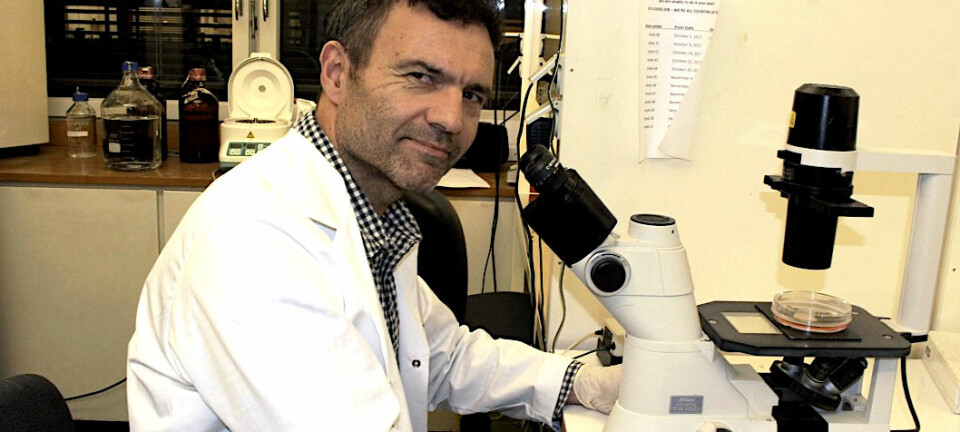This article is produced and financed by University of Oslo - read more

Scientist use space-technology to see how our air is cleaning itself
Thanks to advanced technology, and by knocking out an aircraft window, satellites can now follow vital chemistry in the atmosphere.
There are always lots of chemical reactions going on in the atmosphere. We are completely dependent on some of them. Without them, the earth would be uninhabitable.
“Nature and humans emit a lot of organic molecules. We have to get rid of them somehow. If they had just accumulated in the atmosphere, we would all be dead by now,” says Professor Armin Wisthaler.
One of the most important contributions to this cleaning of the atmosphere comes from OH radicals. OH means they consist of oxygen and hydrogen, and they are called radicals because their electron configuration makes them react very easily with other substances.
For example, they can react with methane, one of the worst greenhouse gases, and thereby remove it from the atmosphere.
“If we reduce the global OH concentration, then methane will live longer in the atmosphere. If we have more OH then methane will live shorter and that is good in a climate perspective,” Wisthaler says to Titan.uio.no.
This is why it is important to know how many OH radicals there are in the atmosphere. Wisthaler, who calls himself an atmospheric chemist, has been involved in an experiment that makes it possible to measure this via satellites orbiting the earth.
Isoprene is an important player
Isoprene is a molecule with which these OH radicals react easily. Isoprene (C5H8) consists of five carbon atoms and eight hydrogen atoms.
“What is special about isoprene for an atmospheric chemist, is that it has two double bonds which makes it a very, very reactive molecule,” Wisthaler says.
“Isoprene is one of the most reactive molecules in the atmosphere. It lives there maybe for just an hour and is one of the main players in short term atmospheric chemistry.”
Isoprene thus plays a key role in determining the abundance of OH radicals in the atmosphere and thereby affects the atmospheric lifetime of other organic gases such as methane.

Oak and poplar are the main culprits
It is nature itself that makes isoprene.
“Basically, it is trees, mostly oak and poplar trees,” Wisthaler says.
There is currently no definite answer to why the trees do this. Wisthaler says that the biologists' main hypothesis is that the production of isoprene can protect the leaves from sudden heating. This can damage the leaves, but by making isoprene they get rid of some energy.
There is also uncertainty about exactly how much isoprene is released, but probably between 200 and 1000 million tonnes per year. Isoprene is not dangerous to breathe. In fact, we also exhale isoprene in small amounts.
However, when isoprene reacts with other substances, harmful air pollution can be formed.
“When isoprene breaks down in the atmosphere, it contributes to the formation of ozone,” Wisthaler says.
Ozone is of course a good thing way up there in the protective ozone layer. Down here at the earth's surface it is another matter entirely.
“At ground level, ozone is harmful. Both for humans to inhale and for plants,” Wisthaler says.
Isoprene also contributes to the formation of particles in the air that can be harmful both to our health and to the climate.

Knocked out windows in aircraft
This is why Wisthaler has assisted American colleagues during experiments in the southeastern United States, where they have problems with poor air quality and high ozone levels.
Researchers from the University of Minnesota use satellites to monitor the chemistry of the atmosphere. To make sure they can trust what the satellites see, they must combine this with actual measurements of what is present in the air.
“Our contribution is that we have developed a new mass spectrometer that can measure hydrocarbons, like isoprene, very, very fast. We can measure at ten points in one second,” Wisthaler says.
It has to be that effective because the measurements take place in a NASA research aircraft that moves 100-200 meters per second. To achieve this, they have knocked out one of the windows in the plane and replaced it with a metal plate with a hole in it.
“We stick a tube out of the window and suck the air into the aircraft and into the mass spectrometer. It is a very sophisticated tube,” Wisthaler says.
It can get very cold up there and the pipe must be heated so that not everything freezes in the pipe before they get the air into the aircraft. On the way into the spectrometer located inside the aircraft, the organic molecules get an electric charge so that it is possible to measure them.
“You cannot analyze neutral compounds. You have to charge them,” Wisthaler says.
“We can also measure the weight very accurately. From the weight, we can determine the elemental composition. If we find molecules with five carbons and eight hydrogens in large amounts over a forest, then we know it is isoprene.”
From local to global surveillance
The goal of these experiments locally in the United States is to understand the chemistry of the atmosphere on a global scale. Using these flight measurements, they have been able to confirm and improve the models they use to interpret data from the satellites.
“The ambition is to have satellites in the air that can do global monitoring of atmospheric constituents,” Wisthaler says.
“This is very important because we want to know the self-cleaning capacity of the atmosphere. We do not know this on a global scale.”
They have already discovered sources of isoprene that no one was aware of.
“Our colleagues found an isoprene hot spot in Africa that was not previously known. Before this new technology, we had to go there and measure.”
This is not necessarily anything the scientists can do if they see high concentrations of isoprene. The purpose is first and foremost to better understand how the world is working.
“Atmospheric chemistry is part of the earth system and we want to understand it on a global scale,” Wisthaler says.
Reference:
Kelley C. Wells et.al.: Satellite isoprene retrievals constrain emissions and atmospheric oxidation. Nature, 2020. Summary
———
Read the Norwegian version of this article at forskning.no


































